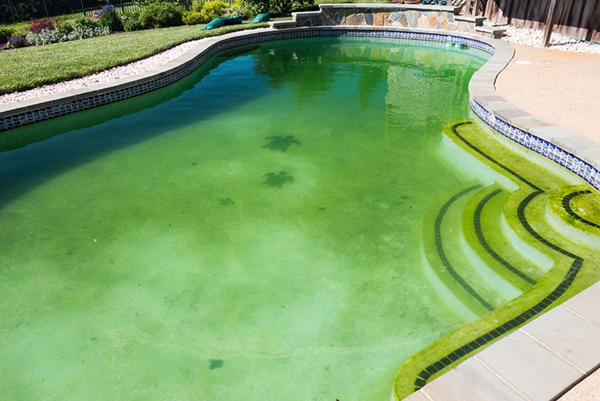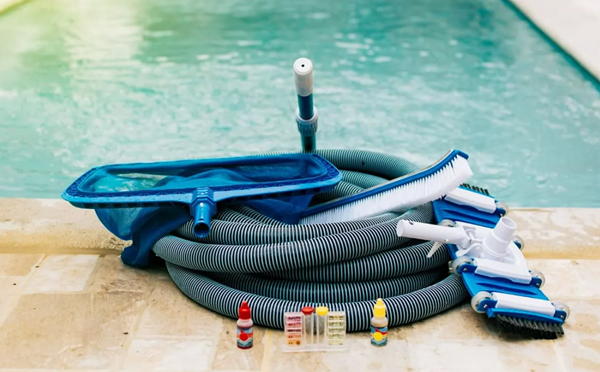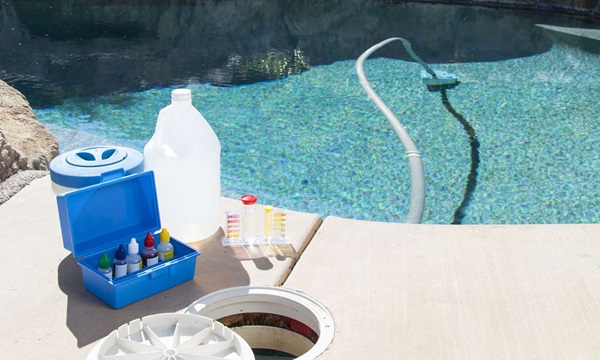A clean pool faucet is vital to maintaining a healthy and enjoyable pool environment. How to clean algae from pool hose and keep your pool sparkling? By following the simple steps below, you can eliminate algae and prevent future growth, ensuring your pool remains a refreshing oasis for years to come.
Understanding Algae: Types and Threats They Pose to Your Pool
Understanding algae and the threats they pose to your pool is crucial for maintaining water quality and equipment longevity.

Differentiating Between Green, Black, and Yellow Algae
Pool algae can come in various colors, and each type presents different challenges for pool maintenance. Here’s a breakdown to help you identify green, black, and yellow algae in your pool:
- Green Algae: Green algae are the most common type found in swimming pools. They typically appear as green patches or streaks on pool surfaces and can quickly spread if not treated promptly.
- Black Algae: Black algae are less common but more stubborn to remove. They form dark, black spots on pool surfaces, often with a hard, protective outer layer that makes them resistant to normal chlorine levels.
- Yellow Algae (Mustard Algae): Yellow algae often appear as yellow or mustard-colored patches on pool walls and surfaces. They are resistant to normal chlorine levels and may require specialized treatment for removal.
- Pink Algae: Pink algae, also known as pink slime or pink bacteria, are not true algae but rather bacteria that thrive in low-nutrient environments. They appear as pink or reddish-colored slime on pool surfaces, especially in areas with poor water circulation or low sanitizer levels.
Here’s a table summarizing the key differences:
| Feature | Green Algae | Black Algae | Yellow Algae |
| Commonness | Most common | Less common, but stubborn | Less common |
| Appearance | Light green to dark green, scummy film, or moss patches | Black or dark brown, streaks or patches | Yellow or brownish film or dust |
| Cause | Warm, stagnant water, imbalanced chemistry | Poor circulation and cracks in the pool surface | Warm water, high phosphate levels |
| Treatment | Chlorine shock, balanced chemistry | Strong algaecide, brushing, and chlorine | Phosphate removal shock, brushing, and chlorine |
How Algae Affect Pool Water Quality and Equipment?

Water Discoloration: Algae growth can cause water discoloration, making your pool appear green, cloudy, or discolored. This not only affects the aesthetics but also indicates poor water quality.
Surface Damage: Algae can attach to pool surfaces, such as walls and floors, and promote the growth of biofilm, which can degrade pool finishes and lead to staining and surface deterioration.
Clogging and Damage: Algae can clog pool filters, impede water circulation, and damage pool equipment such as pumps, heaters, and skimmers if left untreated for an extended period.
The Role of Pool Chemistry in Algae Prevention
- Maintaining Proper Chlorine Levels: Chlorine is the primary sanitizer used to control algae growth in pools. Maintaining proper chlorine levels, typically between 1-3 ppm (parts per million), helps prevent algae from proliferating.
- Balanced pH and Alkalinity: Maintaining balanced pH and alkalinity levels is essential for chlorine effectiveness. High pH or alkalinity levels can reduce chlorine’s ability to kill algae effectively.
- Routine Shock Treatments: Periodic shock treatments help oxidize organic contaminants and algae spores, effectively preventing algae growth and maintaining water clarity.
- Algaecide Treatment: Using algaecides as a preventive measure can help inhibit algae growth and supplement chlorine-based sanitizers. Choose algaecides appropriate for your specific algae type for optimal effectiveness.
By understanding the types of algae, their effects on pool water quality and equipment, and the importance of maintaining proper pool chemistry, you can take proactive steps to prevent algae growth and ensure a clean and healthy swimming environment.
Step-by-Step Description to Remove Algae from Pool Hoses

1. Initial Inspection and Preparation for Cleaning
- Check the faucet: inspect the pool faucet for any visible algae growth, especially in areas where water may stagnate or where exposure to light is limited. sunlight.
- Prepare the cleaning solution: Prepare the cleaning solution by mixing chlorine-based pool shock or algaecide with water according to the manufacturer’s instructions. Use a bucket large enough to accommodate the length of the tube.
- Safety precautions: Wear protective gloves and eyewear to avoid skin and eye irritation when handling cleaning chemicals.
2. Detailed Cleaning Procedure Using Chemicals and Equipment
- Dip the hose: Dip the entire length of the pool hose into the prepared cleaning solution. Make sure the tube is completely immersed so that the cleaning solution can reach all areas affected by algae growth.
- Soak and stir: Let the tube soak in the cleaning solution for at least 30 minutes to one hour, or as recommended by the manufacturer. Periodically agitate the hose by gently rocking it back and forth to dislodge algae buildup.
- Scrubbing (if needed): For stubborn algae stains, use a brush or soft-bristled sponge to scrub the affected areas of the tube. Be gentle to avoid damaging the pipe material.
- Repeat if necessary: If algae growth continues after the initial cleaning, repeat the soaking and scrubbing process until the algae is completely removed.
3. Rinsing and Reassembling Your Pool Hose
- Wash thoroughly: After cleaning, remove the tube from the cleaning solution and rinse thoroughly with clean water. Use a garden hose or sprinkler to drain off any remaining cleaning solution and algae debris.
- Check for residue: inspect the hose for residual algae residue or discoloration. Repeat the cleaning process if necessary until the tube is completely clean.
- Completely dry: Allow the hose to air dry completely before reinstalling and reconnecting to your pool filtration system. Make sure the tube is completely dry to avoid mold growth.
Choosing the Right Equipment and Chemicals for Algae Removal

Review of Pool Vacuums and Vacuum Hoses for Algae Cleaning
Pool Vacuums: When selecting a pool vacuum for algae cleaning, consider options such as manual vacuum heads, automatic robotic cleaners, or water-powered vacuums. Robotic cleaners are particularly effective for removing algae from pool surfaces, while water-powered vacuums are suitable for spot cleaning and smaller algae patches.
Vacuum Hoses: Choose vacuum hoses that are durable, flexible, and resistant to algae growth. Look for hoses made of high-quality materials such as reinforced PVC or spiral-wound construction to withstand harsh pool environments and facilitate effective algae removal.
Effective Chemicals and Natural Solutions for Algae Treatment
Chlorine-based Shock: Chlorine-based shock treatments are commonly used to treat algae outbreaks in pools. Shocking the pool with a high dose of chlorine effectively kills algae spores and helps restore water clarity.
Algaecides: Algaecides are chemical treatments designed specifically to prevent and control algae growth in pools. Choose an algaecide suitable for your algae type (green, black, or yellow) and follow the manufacturer’s instructions for proper application.
Natural Solutions: Some pool owners prefer natural solutions for algae treatment, such as baking soda, vinegar, or hydrogen peroxide. While these options may be less effective than chemical treatments, they can be used as supplementary measures for mild algae outbreaks or as preventive maintenance.
When to Consider a Professional Pool Cleaning Service?
Persistent Algae Problems: If you’ve tried DIY algae treatments without success or if algae outbreaks recur frequently, it may be time to seek professional assistance. Professional pool cleaners have the expertise and specialized equipment to diagnose and treat stubborn algae problems effectively.
Equipment Malfunction: If your pool equipment, such as pumps, filters, or vacuum systems, malfunctions or fails to effectively remove algae, professional repair or replacement may be necessary to restore proper function and prevent future algae outbreaks.
Time and Convenience: If you lack the time, knowledge, or resources to perform regular pool maintenance and algae treatment, hiring a professional pool cleaning service can save you time and hassle while ensuring your pool remains clean and algae-free.
DIY Algae Cleaning Tips from Pool Maintenance Experts
Here are some DIY algae cleaning tips from pool maintenance experts, along with homemade solutions and techniques for algae removal, maintaining your pool post-algae cleanup, and common mistakes to avoid when cleaning algae from pool hoses:

- Regular Brushing: Brush pool surfaces regularly to prevent algae buildup and promote circulation. Focus on areas prone to algae growth, such as walls, steps, and corners.
- Maintain Proper Water Chemistry: Monitor and maintain balanced pH, alkalinity, and sanitizer levels to prevent algae growth. Proper water chemistry helps keep algae at bay and ensures effective treatment.
- Shock Treatment: Periodically shock your pool with a chlorine-based shock treatment to kill algae spores and restore water clarity. Follow the manufacturer’s instructions for proper shock dosage and application.
- Algaecide Treatment: Use an algaecide as a preventive measure or to treat existing algae outbreaks. Choose an algaecide suitable for your algae type and follow the recommended dosage and application instructions.
- Natural Solutions: Consider using homemade solutions such as baking soda, vinegar, or hydrogen peroxide as supplementary measures for mild algae outbreaks or preventive maintenance.
Homemade Solutions and Techniques for Algae Removal
Vinegar Solution: Mix equal parts vinegar and water in a spray bottle and apply it directly to algae-affected areas. Let it sit for a few minutes before scrubbing with a brush and rinsing thoroughly.
Baking Soda Scrub: Create a paste using baking soda and water and apply it to algae spots. Allow it to sit for a few minutes before scrubbing it with a brush and rinsing.
Hydrogen Peroxide Treatment: Add hydrogen peroxide to the pool water at a concentration of 1 cup per 250 gallons to kill algae. Allow the peroxide to circulate for several hours before retesting and adjusting the water chemistry as needed.
Maintaining Your Pool Post-Algae Cleanup
Regular Maintenance: Continue to monitor water chemistry, brush pool surfaces, and maintain proper filtration and circulation to prevent algae from returning.
Shock Treatments: Incorporate periodic shock treatments into your pool maintenance routine to prevent algae outbreaks and maintain water clarity.
Algaecide Treatment: Use algaecides as a preventive measure to inhibit algae growth and supplement chlorine-based sanitizers.
Common Mistakes to Avoid When Cleaning Algae from Pool Hoses
- Using Harsh Chemicals: Avoid using harsh chemicals or abrasive cleaners that may damage pool hoses. Stick to mild cleaning solutions and gentle scrubbing techniques.
- Neglecting Proper Rinse: Ensure thorough rinsing of pool hoses after cleaning to remove any residual cleaning solution or algae debris. Residual chemicals or debris left in the hose can contaminate pool water and promote algae growth.
- Overlooking Hose Maintenance: Regularly inspect pool hoses for signs of wear, damage, or algae growth and address any issues promptly. Proper hose maintenance helps prevent algae buildup and prolongs the lifespan of your pool equipment.
By following these DIY algae cleaning tips, utilizing homemade solutions and techniques for algae removal, maintaining your pool post-algae cleanup, and avoiding common mistakes when cleaning algae from pool hoses, you can effectively treat and prevent algae outbreaks and keep your pool clean and healthy.
Preventative Measures: Keeping Algae Out of Your Pool in the Future
Preventative measures are key to keeping algae out of your pool in the future. Here’s how you can establish a regular pool maintenance schedule, adjust pool chemistry, and consider innovative pool equipment upgrades to prevent algae growth:

Regular Pool Maintenance Schedule to Prevent Algae Growth
Skimming and Vacuuming: Skim the pool surface regularly to remove leaves, debris, and organic matter that can contribute to algae growth. Vacuum the pool at least once a week to eliminate any settled debris and prevent algae buildup.
Brushing: Brush pool walls, steps, and corners on a weekly basis to disrupt algae growth and prevent it from adhering to surfaces. Focus on areas with poor circulation or low sunlight exposure, where algae are more likely to thrive.
Filter Cleaning: Clean or backwash your pool filter regularly to ensure optimal filtration and water circulation. A clean filter helps remove algae spores and prevents them from proliferating in the pool water.
Water Level Maintenance: Maintain proper water levels in the pool to ensure optimal skimming and filtration. A consistent water level helps prevent stagnant areas where algae can accumulate.
Adjusting Pool Chemistry for Algae Prevention
Maintain Balanced pH and Alkalinity: Keep pH levels between 7.4 and 7.6 and alkalinity between 80 and 120 ppm (parts per million). Balanced pH and alkalinity levels optimize the effectiveness of chlorine and other sanitizers in preventing algae growth.
Chlorine Levels: Maintain adequate chlorine levels between 1 and 3 ppm to effectively kill algae spores and inhibit their growth. Shock the pool periodically to boost chlorine levels and eliminate any lingering algae or organic contaminants.
Algaecide Treatment: Use algaecides as a preventive measure to inhibit algae growth and supplement chlorine-based sanitizers. Choose an algaecide appropriate for your pool type and algae species, and follow the manufacturer’s instructions for proper application.
Innovative Pool Equipment Upgrades to Keep Algae at Bay
Robotic Pool Cleaners: Consider investing in a robotic pool cleaner with advanced cleaning capabilities, such as scrubbing brushes and powerful suction, to effectively remove debris and prevent algae buildup.
UV-C Sanitizers: UV-C sanitizers use ultraviolet light to kill bacteria, viruses, and algae in pool water. Installing a UV-C sanitizer as part of your pool filtration system can provide an additional layer of protection against algae growth.
Variable-Speed Pumps: Upgrade to a variable-speed pump with customizable flow rates to optimize water circulation and filtration. Proper water circulation helps prevent stagnant areas where algae can thrive and ensures uniform distribution of sanitizers throughout the pool.
Algae Cleaning FAQs: Expert Answers to Your Most Common Questions

How Often Should I Clean My Pool Hose to Prevent Algae?
It’s recommended to clean your pool hose regularly as part of your routine pool maintenance, especially if you notice any signs of algae growth or debris accumulation.
Ideally, you should inspect and clean your pool hose every few weeks or whenever you perform a thorough cleaning of your pool. Keeping your pool hose clean helps prevent algae buildup and ensures optimal performance of your pool equipment.
Can I Prevent Algae Growth in My Pool Without Chemicals?
While chemicals such as chlorine and algaecides are commonly used to prevent algae growth in pools, there are alternative methods to minimize algae without relying solely on chemicals.
These methods include maintaining proper water circulation and filtration, regularly brushing pool surfaces to disrupt algae growth, ensuring balanced pH and alkalinity levels, and implementing natural or DIY solutions such as baking soda or vinegar treatments.
While these methods may not be as potent as chemical treatments, they can complement your overall algae prevention strategy and reduce the need for chemical interventions.
Is It Necessary to Replace My Pool Hose After Algae Infestation?
If your pool hose has been heavily infested with algae or shows signs of damage or deterioration as a result of the infestation, it may be necessary to replace it. Algae can adhere to the inner walls of the hose and create stubborn stains or odors that are difficult to remove, even with thorough cleaning.
Additionally, prolonged exposure to algae and harsh cleaning chemicals can weaken the hose material and compromise its structural integrity. Inspect your pool hose carefully after an algae infestation, and if you notice any signs of damage or persistent algae residue, consider replacing the hose to ensure optimal performance and hygiene.
By addressing these frequently asked questions about algae cleaning, you can better understand how to prevent algae growth in your pool, maintain the cleanliness of your pool hose, and ensure a clean and healthy swimming environment for you and your family.

Meet David Thomas, a seasoned professional with nearly 8 years of experience specializing in inspecting and resolving issues related to swimming pools. With his expertise and meticulous attention to detail, David ensures the safety and functionality of pools, making them a refreshing oasis for all to enjoy. Whether it’s troubleshooting equipment or maintaining water quality, David’s proficiency guarantees top-notch solutions tailored to meet every pool owner’s needs.
